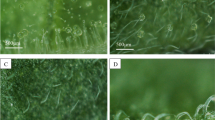Abstract
The whitefly (Bemisia tabaci) is a well-known pest of vegetables and ornamental cash crops including tomato plant. Tomato plant disorders, in many instances, are related mostly with the silver leaf whitefly (Bemisia tabaci) feeding. It is well thought out that tomato plant is one of the most favorable host plants for the whitefly. Thus we aimed to study distinctive morphological characteristics of the leaves in seven selected tomato varieties including trichome density, trichome length, leaf lamina thickness and RGB value (red, green, blue) and HSB value (hue, saturation, brightness). Seven hybrid F1 tomato varieties such as TO-1057, TAI-1757, T‑1359, Advanta-1247, New Super, Sultan and Super were tested for the whitefly preferences. Our study suggests that T‑1359 is the highly preferred variety for the whitefly adults (5.32 ± 0.81) and nymphs (6.30 ± 1.13) population. In contrast, Advanta-1247 exhibits the lowest population of whitefly adults (2.71 ± 0.70) and nymphs (1.88 ± 0.43). This study systematically identifies the morphological characters of the tomato plants alongside the whitefly population. The study can be potentially extended to other crops as well.
Zusammenfassung
Die Weiße Fliege (Bemisia tabaci) ist ein bekannter Schädling von Gemüse und Zierpflanzen einschließlich Tomatenpflanzen. Erkrankungen der Tomatenpflanzen sind in vielen Fällen hauptsächlich auf den Fraß durch die Weiße Fliege (Bemisia tabaci) zurückzuführen. Es ist bekannt, dass die Tomatenpflanze eine der günstigsten Wirtspflanzen für die Weiße Fliege ist. Daher war es unser Ziel, die charakteristischen morphologischen Eigenschaften der Blätter in sieben ausgewählten Tomatensorten zu untersuchen, darunter die Dichte und Länge der Trichome, die Dicke der Blattlamina, der RGB-Wert (Rot, Grün, Blau) und der HSB-Wert (hue, saturation, brightness = Farbton, Sättigung, Helligkeit). Sieben hybride F1-Tomatensorten wurden bezüglich der Präferenzen der Weiße Fliege getestet: TO-1057, TAI-1757, T‑1359, Advanta-1247, New Super, Sultan und Super. Unsere Studie deutet darauf hin, dass T‑1359 bei erwachsenen Weißen Fliegen (5,32 ± 0,81) und Nymphen (6,30 ± 1,13) eine sehr bevorzugte Sorte ist. Im Gegensatz dazu weist Advanta-1247 die niedrigste Population an erwachsenen Weißen Fliegen (2,71 ± 0,70) und Nymphen (1,88 ± 0,43) auf. Diese Studie identifiziert systematisch die morphologischen Merkmale der Tomatenpflanzen in Verbindung mit der Population der Weißen Fliege. Die Studie kann möglicherweise auch auf andere Kulturen ausgeweitet werden.






Similar content being viewed by others
References
Abdul-Baki AA (1991) Tolerance of tomato cultivars and selected germplasm to heat stress. J Am Soc Hortic Sci 116:1113–1116
Acharya V, Singh A (2008) Biochemical basis of resistance in cotton to the whitefly, Bemisia tabaci Genn. J Cotton Res Dev 22:195–199
Ahmad M, Arif MI, Naveed M (2010) Dynamics of resistance to organophosphate and carbamate insecticides in the cotton whitefly Bemisia tabaci (Hemiptera: Aleyrodidae) from Pakistan. J Pest Sci 83:409–420. https://doi.org/10.1007/s10340-010-0311-8
Ayyasamy R, Baskaran P (2005) Influence of certain leaf characters of brinjal accessions with incidence of Bemisia tabaci. J Food Agric Environ 3(2):333–334
Buitenhuis R, Shipp JL (2006) Factors influencing the use of trap plants for the control of (Thysanoptera: Thripidae) on greenhouse potted chrysanthemum. Environ Entomol 35:1411–1416
Butter N, Vir B (1989) Morphological basis of resistance in cotton to the WhiteflyBemisia Tabaci. Phytoparasitica 17:251
David BV, Regu K (1995) Aleurodicus dispersus Russell (Aleyrodidae: Homoptera), a whitefly pest new to India. Pestology 19:5–7
Dicke M, Baldwin IT (2010) The evolutionary context for herbivore-induced plant volatiles: beyond the ‘cry for help’. Trends Plant Sci 15:167–175
Foster SP, Harris MO (1997) Behavioral manipulation methods for insect pestmanagement. Annu Rev Entomol 42:123–146
Gopi D, Neelannavar TN, Thirumurthi S (2001) Incidence of spiralling whitefly, Aleurodicus dispersus among tree species. Abstracts, National Seminar on Emerging Trends in Pests & Diseases and their Management, Coimbatore, 11–13 October 2001. abstract ENT 75l. Tamil Nadu Agricultura University, Coimbatore, pp 71–72
Hare JD, Elle E (2002) Variable impact of diverse insect herbivores on dimorphic Datura wrightii. Ecology 83:2711–2720
Jiang YX, Walker GP (2007) Identification of phloem sieve elements as the site of resistance to silverleaf whitefly in resistant alfalfa genotypes. Entomol Exper Applic 125:307–320
Kennedy GG (2003) Tomato, pests, parasitoids, and predators: tritrophic interactions involving the genus Lycopersicon. Annu Rev Entomol 48:51–72
Mansoor S, Khan S, Hussain M, Mushtaq N, Zafar Y, Malik K (2000) Evidence that watermelon leaf curl disease in Pakistan is associated with Tomato leaf curl virus-India, a bipartite begomovirus. Plant Dis 84:102–102
Martin JH (1990) The whitefly species Aleurodicus dispersus and its rapid extension of range across the Pacific and South East Asia. MAPPS Newsl 14:36–37
Misra C, Lamba K (1929) The cotton whitefly (Bemisia gossypiperda n. sp,). Agric Res Inst Pusa 196:7
Mumm R, Dicke M (2010) Variation in natural plant products and the attraction of bodyguards involved in indirect plant defense. Can J Zool 88:628–667
Oriani MG, Vendramim JD, Brunherotto R (2005) Influência dos tricomas na preferência para oviposição de Bemisia tabaci (Genn.) biótipo B (Hemiptera: Aleyrodidae) em genótipos de feijoeiro Neotropical entomology
Ozgur A, Sekeroglu E (1986) Population development of Bemisia tabaci (Homoptera: Aleurodidae) on various cotton cultivars in Cukurova. Turk Agric Ecosyst Environ 17:83–88
Palaniswami MS, Pillai KS, Nair RR, Mohandas C (1995) A new cassava pest in India. Cassava Newsl 19:6–7
Ramani S (2000) Fortuitous introduction of an aphelinid parasitoid of the spiralling whitefly, Aleurodicus dispersus Russell (Homoptera: Aleyrodidae) into the Lakshadweep islands, with notes on host plants and other natural enemies. J Biol Control 14:55–60
Rustamani M, Khatri I, Leghari M, Sultana R, Mandokhail A (2014) Trichomes of cotton leaf as an aspect of resistance to sucking insect pests. Sindh Univ Res J 46:3
Shepherd RW, Bass WT, Houtz RL, Wagner GJ (2005) Phylloplanins of tobacco are defensive proteins deployed on aerial surfaces by short glandular trichomes. Plant Cell 17:1851–1861
Shibuya T, Rirai N, Sakamoto Y, Komuro J (2009) Effects of morphological characteristics of Cucumis sativus seedlings grown at different vapor pressure deficits on initial colonization of Bemisia tabaci (Hemiptera: Aleyrodidae). ec 102:2265–2267
da Silva JPGF, Baldin ELL, de Souza ES, Lourenção AL (2012) Assessing Bemisia tabaci (Genn.) biotype B resistance in soybean genotypes: antixenosis and antibiosis. Chil J Agric Res 72:516
Simmons AT, Gurr GM (2005) Trichomes of Lycopersicon species and their hybrids: effects on pests and natural enemies. Agric For Entomol 7:265–276
Singh D, Jaglan R, Singh R (2002) Leaf morphological characteristics of brinjal in relation to whitefly incidence Haryana. J Hortic Sci 31:289–291
Srinivasa MV (2000) Host plants of the spiraling whitefly Aleurodicus dispersus Russell (Hemiptera: Aleyrodidae). Pest Manag Hortic Ecosyst 6:79–105
Taggar G, Gill R (2012) Preference of whitefly, Bemisia tabaci, towards black gram genotypes: role of morphological leaf characteristics. Phytoparasitica 40:461–474
Tariq MI, Afzal S, Hussain I, Sultana N (2007) Pesticides exposure in Pakistan: a review. Environ Int 33:1107–1122
Unsicker SB, Kunert G, Gershenzon J (2009) Protective perfumes: the role of vegetative volatiles in plant defense against herbivores. Curr Opin Plant Biol 12:479–485
Author information
Authors and Affiliations
Corresponding author
Ethics declarations
Conflict of interest
H. Rehman, A. Bukaro, A. Ghani Lanjar and L. Bashir declare that they have no competing interests.
Rights and permissions
About this article
Cite this article
Rehman, H., Bukero, A., Ghani Lanjar, A. et al. Investigation of Varietal Characteristics of Tomato Plants for Determining the Diverse Preferences of Bemisia Tabaci (Aleyrodidea: Hemiptera). Gesunde Pflanzen 72, 163–170 (2020). https://doi.org/10.1007/s10343-019-00497-z
Received:
Accepted:
Published:
Issue Date:
DOI: https://doi.org/10.1007/s10343-019-00497-z




